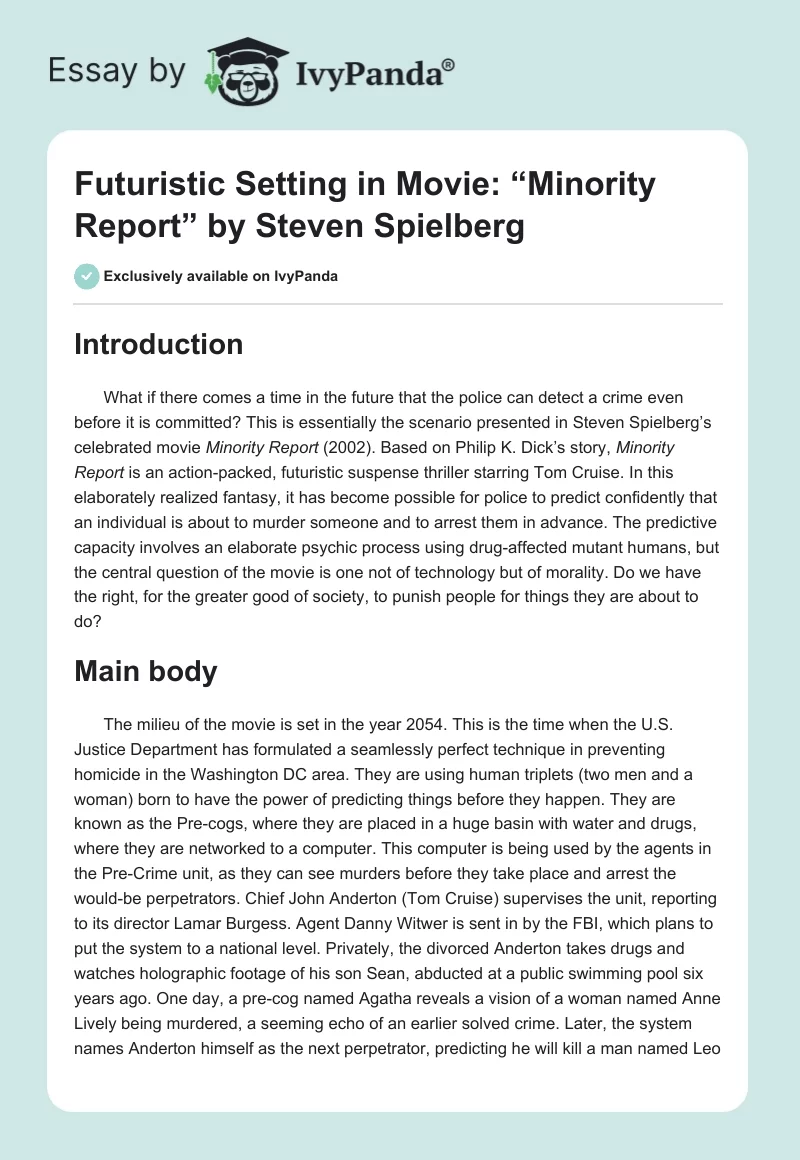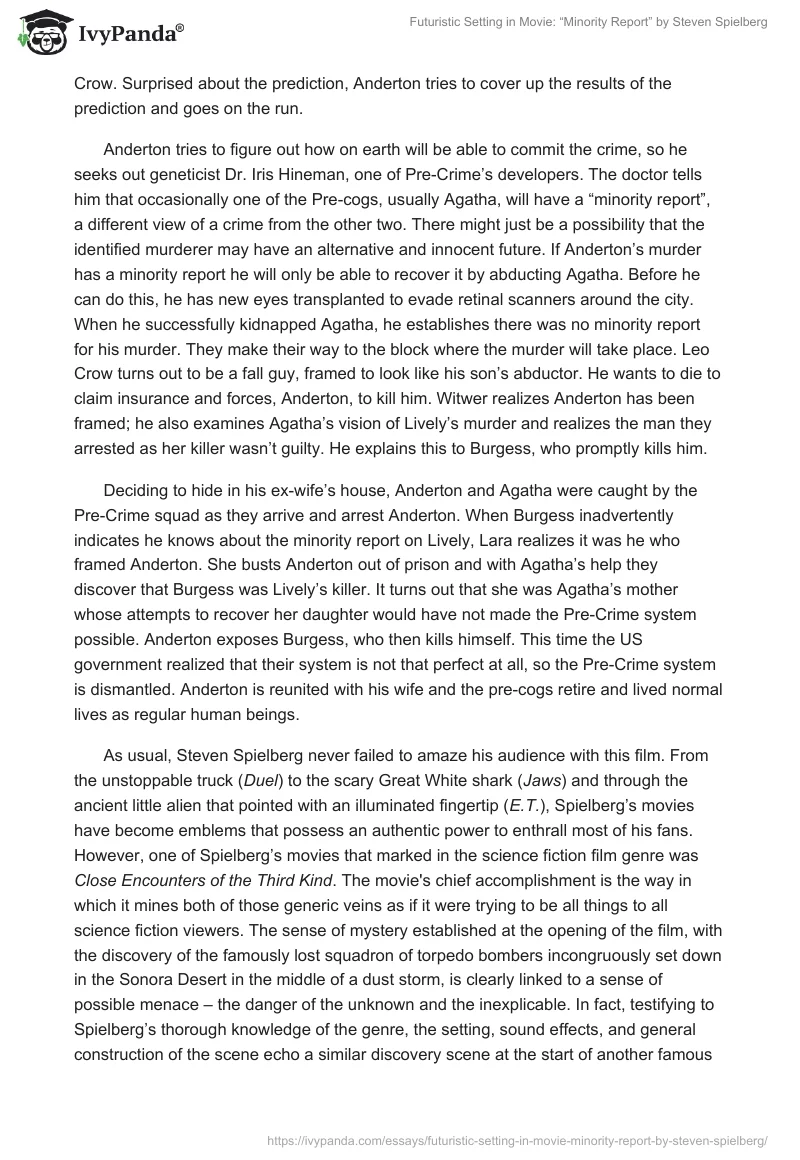Introduction
What if there comes a time in the future that the police can detect a crime even before it is committed? This is essentially the scenario presented in Steven Spielberg’s celebrated movie Minority Report (2002). Based on Philip K. Dick’s story, Minority Report is an action-packed, futuristic suspense thriller starring Tom Cruise. In this elaborately realized fantasy, it has become possible for police to predict confidently that an individual is about to murder someone and to arrest them in advance. The predictive capacity involves an elaborate psychic process using drug-affected mutant humans, but the central question of the movie is one not of technology but of morality. Do we have the right, for the greater good of society, to punish people for things they are about to do?
Main body
The milieu of the movie is set in the year 2054. This is the time when the U.S. Justice Department has formulated a seamlessly perfect technique in preventing homicide in the Washington DC area. They are using human triplets (two men and a woman) born to have the power of predicting things before they happen. They are known as the Pre-cogs, where they are placed in a huge basin with water and drugs, where they are networked to a computer. This computer is being used by the agents in the Pre-Crime unit, as they can see murders before they take place and arrest the would-be perpetrators. Chief John Anderton (Tom Cruise) supervises the unit, reporting to its director Lamar Burgess. Agent Danny Witwer is sent in by the FBI, which plans to put the system to a national level. Privately, the divorced Anderton takes drugs and watches holographic footage of his son Sean, abducted at a public swimming pool six years ago. One day, a pre-cog named Agatha reveals a vision of a woman named Anne Lively being murdered, a seeming echo of an earlier solved crime. Later, the system names Anderton himself as the next perpetrator, predicting he will kill a man named Leo Crow. Surprised about the prediction, Anderton tries to cover up the results of the prediction and goes on the run.
Anderton tries to figure out how on earth will be able to commit the crime, so he seeks out geneticist Dr. Iris Hineman, one of Pre-Crime’s developers. The doctor tells him that occasionally one of the Pre-cogs, usually Agatha, will have a “minority report”, a different view of a crime from the other two. There might just be a possibility that the identified murderer may have an alternative and innocent future. If Anderton’s murder has a minority report he will only be able to recover it by abducting Agatha. Before he can do this, he has new eyes transplanted to evade retinal scanners around the city. When he successfully kidnapped Agatha, he establishes there was no minority report for his murder. They make their way to the block where the murder will take place. Leo Crow turns out to be a fall guy, framed to look like his son’s abductor. He wants to die to claim insurance and forces, Anderton, to kill him. Witwer realizes Anderton has been framed; he also examines Agatha’s vision of Lively’s murder and realizes the man they arrested as her killer wasn’t guilty. He explains this to Burgess, who promptly kills him.
Deciding to hide in his ex-wife’s house, Anderton and Agatha were caught by the Pre-Crime squad as they arrive and arrest Anderton. When Burgess inadvertently indicates he knows about the minority report on Lively, Lara realizes it was he who framed Anderton. She busts Anderton out of prison and with Agatha’s help they discover that Burgess was Lively’s killer. It turns out that she was Agatha’s mother whose attempts to recover her daughter would have not made the Pre-Crime system possible. Anderton exposes Burgess, who then kills himself. This time the US government realized that their system is not that perfect at all, so the Pre-Crime system is dismantled. Anderton is reunited with his wife and the pre-cogs retire and lived normal lives as regular human beings.
As usual, Steven Spielberg never failed to amaze his audience with this film. From the unstoppable truck (Duel) to the scary Great White shark (Jaws) and through the ancient little alien that pointed with an illuminated fingertip (E.T.), Spielberg’s movies have become emblems that possess an authentic power to enthrall most of his fans. However, one of Spielberg’s movies that marked in the science fiction film genre was Close Encounters of the Third Kind. The movie’s chief accomplishment is the way in which it mines both of those generic veins as if it were trying to be all things to all science fiction viewers. The sense of mystery established at the opening of the film, with the discovery of the famously lost squadron of torpedo bombers incongruously set down in the Sonora Desert in the middle of a dust storm, is clearly linked to a sense of possible menace – the danger of the unknown and the inexplicable. In fact, testifying to Spielberg’s thorough knowledge of the genre, the setting, sound effects, and general construction of the scene echo a similar discovery scene at the start of another famous “invasion” film. As the narrative advances, Spielberg employs a variety of tricks, reminiscent especially of the horror film and worked out in his previous movies, like Duel (1971) and Jaws (1977), to further that eerie tone and manipulate our sense of the other. Electrical appliances that turn on and off, as if moved by some unseen power, mechanical toys that suddenly start-up by themselves, blinding lights from various mysterious or unknown sources, strange noises, jump cuts for shock effect – these are the sorts of effects that we encounter at every turn in Close Encounters of the Third Kind (Telotte, 2001, p. 148). These same techniques in storytelling are still reminiscent of the movie Minority Report. Here, Spielberg presents a scary future where citizens are subjected to constant surveillance through retinal scans as individuals are arrested and imprisoned for crimes they have not yet committed but of which the police have foreknowledge (Creed 192).
True enough, according to Kaufman (22 July 2002), Spielberg is entirely himself during the whole movie as he demonstrates “his typical cinematic verve”. For instance, the opening montage exhibits a “faintly humorous yet grim way in which the flying cops are handled”. As Spielberg’s earlier science fiction, Close Encounters of the Third Kind and E.T. glowed with humanistic concern, “Minority Report has more than a whiff of that aroma”. At present, directors have transformed into technological wizards. Spielberg certainly has the wizardry, but that is not all he has but he can still inject some heart in his movies as “he can deal with human subjects that are richer and more rewarding than the ones in this long but thematically slender screenplay”.
Felperin (August 2002) also thought that underneath Minority Report’s “gorgeous, gaudy gizmos and exquisitely managed set-pieces”, the film is Spielberg’s “rawest exploration yet of anxieties about the imperilment of children”. As the film’s protagonist Anderton’s central quest is to find out why the criminal system he works for has named him a murderer, he has been motivated to prevent crime by his son’s abduction six years ago. As incarnated by alleged off-set control freak Tom Cruise and set up in the film’s opening as a man of supreme competence, Anderton could only be provoked to murder by the man who took his son. Indeed, the film suggests that if the man he eventually confronts were guilty, Anderton would be justified in killing him. The fact that the film’s conclusion tries to smooth things over with the reunion of two families separated because of the Pre-Crime Unit, one for Anderton and his expectant wife (his hand placed on her belly is the film’s most cheesy touch) and one for the pre-cogs, barely alleviates the latent traumas audience have witnessed in the entire film. The guileless humanism (albeit tinged with pain) that has been Spielberg’s trademark since Close Encounters of a Third Kind seems to have been corroded by the darker narratives he’s explored since Schindler’s List. Felperin (August 2002) suggested that Minority Report has “bleak clean surfaces and protofascist dystopia” and “feels far more Kubrickian than A.I.”. However, the film is actually what Spielberg inherited from doing films for different genres. Already the box-office reports suggest Spielberg’s mass audience hasn’t taken well to his newfound pessimism, but film good points will recognize “he’s become a more nuanced and provocative film-maker”.
Also, fans of the original author of the short story Philip K Dick and hardcore sci-fi enthusiasts might be less happy with Spielberg’s version. According to Felperin (August 2002), the only things the film has in common with Dick’s original story are a couple of characters’ names, the Pre-Crime unit conceit, and the title. The futuristic landscape plays cleverly off current issues around nascent technologies, offering a deliciously ironical send-up/total embrace of product placement. The central problem of why the Pre-cogs see only murders is explained with some cursory mumbling about the interconnectedness of all psyches. Otherwise, the script is the best that Spielberg has worked within years.
In this film, Spielberg explores the close relationship of time and interiority that things not done in the world of events, or space, nonetheless have a reality and a complexity in the interior world. And yet this world’s organizing principle, time, has its rules-what has not yet happened can still be changed. The film’s denouement, n which a character has to decide whether to prove the predictive perfection of the system by killing another person, features the dilemma of choice and of free will. Can the rules of time be ignored in order to preserve the safety and lawfulness of the exterior, spatial world? The movie has also allowed us to inhabit an ethical dilemma in which predictive technologies, based upon knowledge of intent, affect and protect our exterior spatial realm of actions. The interplay of these realms, and the role of surveying technologies in this interplay, has been taken, in a mass fantasy, to one of its limit points. In this area, Spielberg has tickled our imagination once again and pushed his audience to think about these possibilities in the future and the dilemmas that will be faced in that particular scenario.
Conclusion
Although one will be annoyed to see brands like Nokia, Lexus, Pepsi, Guinness, Reebok, and American Express in the whole film like it is one big advertising come-on, Spielberg manages to escape from being too commercial as this method lent familiarity to the plot’s futuristic settings. All in all, Spielberg’s Minority Report is an enjoyable film to watch because, despite its dark theme and extremely futuristic setting, it still retains the director’s magical touch to delight all his fans young and old.
Works Cited
Creed, Barbara. Media Matrix: Sexing the New Reality. Crows Nest, N.S.W.: Allen & Unwin, 2003.
Felperin, Leslie. Minority Report. Sight & Sound 12.8 (August 2002): 44-45.
Kauffmann, Stanley. Minority Report. The New Republic 227.4 (July 22 2002): 30-31.
Telotte, J. P. Science Fiction Film. Cambridge, England: Cambridge University Press, 2001.


